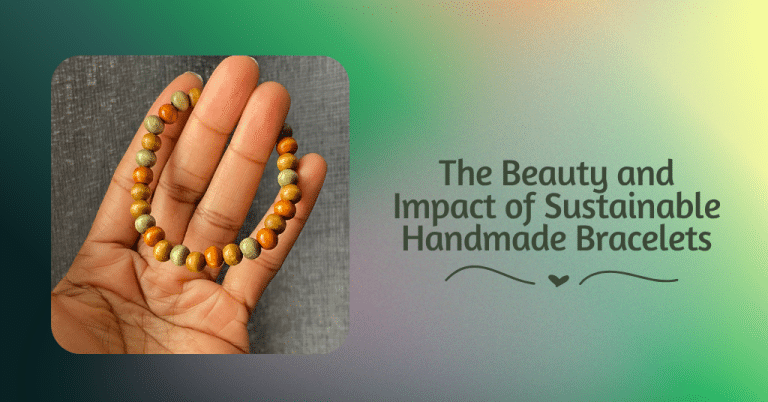A Guide To Bio-Jewellery Longevity: Caring For Your Conscious Creations
Understanding the Organic Materials Used in Bio-Jewellery
Understanding the organic materials used in bio-jewellery is essential for appreciating the unique qualities and maintaining the longevity of these pieces. Bio-jewellery, distinct from traditional jewellery, often incorporates living or once-living materials, such as seeds, shells, wood, leaves, and even bacteria or fungi. These organic components contribute to the individuality of each piece, offering a connection to nature and a reminder of the natural world’s beauty. In this guide to Bio-Jewellery longevity, you will learn how to care for your conscious creations.
Bio-jewellery demands a specific kind of care. Due to their biological origins, these materials can react to environmental factors such as humidity, temperature, light, and chemicals. For instance, excessive moisture can lead to the decay of wood or seed-based components, while prolonged exposure to direct sunlight can fade natural colours. Moreover, organic materials may be more susceptible to scratches or damage.
Therefore, understanding and adapting your care routine to the material’s inherent properties will help preserve its aesthetic and structural integrity, ensuring that your bio-jewellery can be cherished for years to come.
The Art of Wearability: Bio-Jewellery as Wearable Art
Bio-jewellery exists at the intersection of art, science, and personal expression, transforming living materials into exquisite adornments. The art of wearability in bio-jewellery lies in its ability to maintain harmony between its delicate organic components and its ornamental purpose. Each piece is a wearable ecosystem, thriving through careful synergy with the wearer. Bio-jewellery demands mindfulness in its interaction, requiring thoughtful handling to preserve its living elements.
The fragility of these unique creations elevates them beyond mere accessories, highlighting their role as dynamic, wearable art. Choosing bio-jewellery means embracing a lifestyle that respects and nurtures the life embedded within these pieces. The challenge and beauty lie in balancing its aesthetic allure with practical care, creating a unique bond between the jewellery and its wearer. As these living creations respond to their environment, they challenge traditional notions of permanence in jewellery, inviting a deeper engagement with the fleeting beauty of life and nature’s cyclical resilience.
Responsible Care Guidelines for Bio-Jewellery
When caring for bio-jewellery, it’s essential to consider both its organic composition and its artistic value. Bio-jewellery, crafted from living organisms or sustainable materials, requires mindful maintenance to ensure bio-jewellery longevity. Start by storing these pieces away from direct sunlight and humidity, as exposure can degrade organic materials. A cool, dry storage environment is ideal. When cleaning bio-jewellery, avoid harsh chemicals and instead use a soft, damp cloth to gently wipe away any residue, taking care not to damage the surface.
It’s important to minimise the exposure of bio-jewellery to perfumes, lotions, or any substance containing alcohol or acidic components to prevent damage. Wearing bio-jewellery with care is crucial; avoid wearing it while performing rigorous activities or when bathing to reduce the risk of water or sweat-induced damage. Regularly inspect your pieces for any signs of wear or changes in condition, addressing these promptly to prevent further deterioration.
By practising these attentive care techniques, the lifespan and beauty of your bio-jewellery can be significantly extended.
Eco-Friendly Maintenance Tips to Extend the Longevity of Your Bio-Jewellery
To ensure the longevity of your bio-jewellery, adopting eco-friendly maintenance practises is essential. Firstly, keep your pieces out of direct sunlight and away from excessive moisture, as these conditions can degrade natural materials. When cleaning your jewellery, opt for a soft, damp cloth to gently wipe away dirt and oils, avoiding harsh chemicals that could damage organic components. Store items in a cool, dry place, preferably in a container that allows air circulation, to prevent mould or mildew growth.
Regularly inspect your jewellery for any signs of wear or damage, addressing minor issues promptly to avoid further deterioration. For biodegradable materials, consider using natural polishes, such as beeswax, to maintain their sheen without harming the environment. If your bio-jewellery incorporates living elements, ensure they receive appropriate care, such as adequate hydration and light conditions, similar to caring for a houseplant.
Finally, respect the intricate balance of natural elements and craftsmanship, treating each piece with the care and attention it deserves.
Daily Practises for Preserving the Beauty of Bio-Jewellery
To ensure that your bio-jewellery maintains its allure and longevity, integrating mindful daily practises into your routine is essential. Begin by storing your pieces in a dry, enclosed environment away from direct sunlight to prevent degradation from UV exposure. Regularly clean your bio-jewellery using a soft, damp cloth to remove any dirt or oils accumulated from daily wear, avoiding harsh chemicals that may compromise the organic materials.
Consider wearing your jewellery only after applying perfumes, lotions, or hairsprays, as these substances can interact with and weaken the natural elements. It’s also wise to remove your pieces before engaging in activities that could expose them to excessive moisture or physical stress, such as swimming, exercising, or sleeping. Paying attention to environmental factors like humidity and temperature fluctuations can further preserve the beauty of your bio-jewellery.
By conscientiously attending to these aspects of care, you will help prolong the life and aesthetic appeal of these unique, living adornments, allowing them to remain vibrant and cherished over time.
Embracing Eco-Friendly and Ethical Fashion Practises
Bio-jewellery represents a harmonious blend of fashion and sustainability, aligning with the increasing demand for eco-friendly and ethical practises in the industry. Embracing bio-jewellery means more than opting for a new style; it signifies a commitment to a lifestyle that respects and nurtures our planet. This innovative form of adornment utilises organic materials, often sourced ethically and responsibly, to craft pieces that are not only aesthetically pleasing but also imbued with a deeper narrative of consciousness.
By choosing bio-jewellery, consumers take an active role in reducing the environmental impact typically associated with traditional jewellery production. This involves considering the lifespan of materials, the methods of production, and the social implications of the supply chain. Through thoughtful design and mindful sourcing, bio-jewellery artisans create pieces that celebrate natural beauty while fostering sustainability and fairness. As awareness grows about the interconnectedness of our choices and their effects on the environment, bio-jewellery offers a tangible way to support a more ethical and eco-friendly future in fashion.
Optimal Storage Solutions for Organic Wearables
When it comes to bio-jewellery, optimal storage solutions play a vital role in maintaining the longevity and beauty of these organic wearables. Bio-jewels, crafted with sensitive organic materials, require a thoughtful approach to storage to prevent deterioration. The first consideration is the environment; they should be stored in a cool, dry place, away from direct sunlight and humidity, which can accelerate decay or cause them to warp.
Bio-jewellery pieces, like other organic materials, are best stored in glass containers to protect them from degradation caused by light, moisture, and potential chemical reactions. Glass provides a stable, inert barrier, preventing harmful UV rays from damaging the jewellery and inhibiting oxidation or other reactions that could discolour or weaken the materials.
Utilising acid-free storage containers or pouches can help protect against unnecessary chemical reactions. Additionally, keeping bio-jewellery away from extreme temperature fluctuations is essential, as these can weaken or damage the organic components. To prevent scratches or wear, individual wrapping with soft, natural materials like cotton or linen is recommended to provide cushioning. Keeping these organic items in a dust-free environment also minimises the buildup of particles that could mar the surface over time.
Periodically inspecting your bio-jewels ensures that any signs of deterioration are addressed quickly, sustaining their artistry and vital connection to the natural world.






Leave a Reply